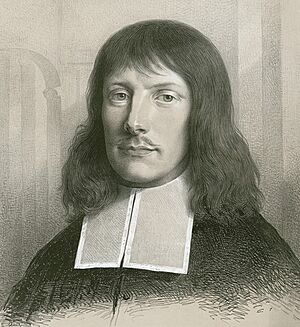Joachim Neander facts for kids
Quick facts for kids Joachim Neander |
|
|---|---|

Lithograph of Neander (19th century)
|
|
| Personal details | |
| Born | 1650 Bremen, Holy Roman Empire |
| Died | 31 May 1680 Bremen, Holy Roman Empire |
Joachim Neander (1650–31 May 1680) was a German Reformed church teacher, theologian (someone who studies religion), and hymnwriter. A hymnwriter creates songs of praise, often for church services. His most famous hymn is Praise to the Lord, the Almighty, the King of Creation.
This hymn is very popular and has been translated into English many times. It appears in most major hymnals (books of hymns). Many people consider Neander to be the first important German hymn writer after the Reformation. He is known as the best hymn writer of the German Reformed Church. He wrote about 60 hymns and even created the music for many of them.
Contents
Joachim Neander's Life Story
Joachim Neander was born in Bremen, which was part of the Holy Roman Empire at the time. His father was a Latin teacher. His grandfather, who was a musician, changed the family name from the German Neumann (meaning 'New man') to Neander. This was a popular trend back then to use Greek or Roman-sounding names.
After his father passed away, Joachim couldn't afford to go to a famous university. So, he studied theology in his hometown from 1666 to 1670. At first, he wasn't very serious about his studies. But near the end of his course, he heard a sermon by Theodor Undereyk. This sermon deeply affected him and made his beliefs much stronger.
Time in Düsseldorf
In 1671, Joachim became a private tutor in Heidelberg. Then, in 1674, he became a teacher at a Latin school in Düsseldorf. This was an important step before becoming a minister. While living in Düsseldorf, he loved to visit the nearby Düssel river valley. Nature often inspired his poems and hymns.
He also held special gatherings and services in the valley, where he gave sermons. The valley was later renamed Neandertal (originally Neanderthal) in his honor in the early 19th century. This is the same valley where the famous Neanderthal human remains were later discovered!
Return to Bremen and Early Death
In 1679, Neander became a pastor (a church leader) at St Martin’s church in Bremen. He had become very popular with ordinary people, which had caused some disagreements with the church leaders in Düsseldorf.
Sadly, just one year later, at the age of 30, he passed away from tuberculosis.
His Hymns and Challenges
Joachim Neander wrote most of his hymns while he was in Düsseldorf. He is considered the first important hymn writer of the German Reformed Church.
Disagreements in Düsseldorf
The church leaders in Düsseldorf had full control over the school where Neander taught. For a few years, he worked well with the minister, Sylvester Lürsen. Neander often preached in the church and helped visit sick people.
However, Neander soon started doing things differently. He began holding his own prayer meetings without telling the minister or elders. He also stopped taking Holy Communion, believing he shouldn't share it with people he felt weren't truly committed. He even convinced others to do the same. He also became less regular at the usual church services.
Besides these issues, he changed the school timetable, made changes to the school buildings, and held exams and holidays without asking anyone.
Resolution of the Conflict
Because of these actions, the school was officially reviewed on November 29, 1676. Then, on February 3, 1677, he was temporarily stopped from teaching and preaching.
Just 14 days later, on February 17, he signed a document agreeing not to repeat any of the actions that had caused problems. After signing, he was allowed to go back to his job as rector (head teacher) but not as an assistant minister. His salary was never actually stopped.
Stories that he was forced to leave Düsseldorf or that he lived in a cave in the Neanderthal for months are not true. Still, having to sign such a document must have been difficult for him.
How His Hymns Were Published
Many of Neander's hymns were first shared among his friends in Düsseldorf as handwritten copies. They were later collected and published after he moved to Bremen.
His first collection of hymns was published in 1680, the year he died. It was called A und Ώ, Joachimi Neandri Glaub-und Liebesübung. More editions quickly followed in the years after his death.
His hymns became very popular and were included in many hymnbooks. For example, in 1722, his collection of hymns, called Bundeslieder, became a main part of the Marburg Reformed Gesang-Buch.
His hymns were especially loved in the area near Düsseldorf and on the Ruhr river. Even long after his death, people there remembered and honored his name.

